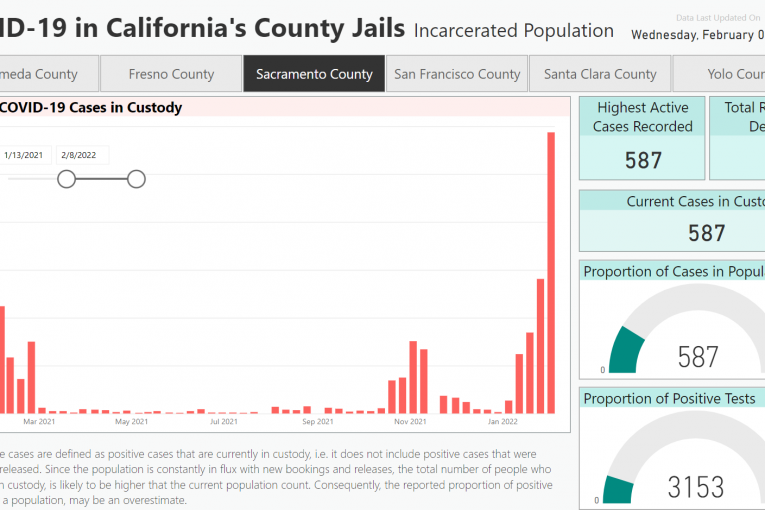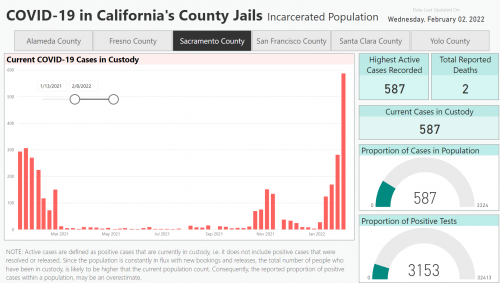
By Aparna Komarla & Sophia Juliana-Baltasar
This report is written by the Covid In-Custody Project — an independent journalism project that partners with the Davis Vanguard to bring reporting on the pandemic in California’s county jails and Department of Corrections and Rehabilitation (CDCR) to the public eye. Refer to our website to view and download the raw data.
Sacramento County’s jails are in the midst of their second COVID-19 outbreak in the last 3 months. In October of last year, the sheriff’s office reported 150 positive cases and two COVID-related deaths in the main jail and Rio Cosumnes Correctional Center (RCCC). This month, positive cases have quadrupled, affecting almost 20% of roughly 3,300 people incarcerated across both facilities.

The high infection rate in Sacramento’s jails is in contrast to other counties such as San Francisco, which reported less than 40 positive cases across all jails during the peak of the Omicron surge. The population in these jails is also less than 900.
Dr. Sandy Damiano, the director of Adult Correctional Health, has stated that handling the current outbreak in Sacramento’s jails is “tremendously difficult” due to the virus’ “high infectiousness and short incubation period.” With a jail vaccination rate of just 30%, a rising population, and little to no information on testing and vaccinations for correctional staff, it is unclear how the county’s jail system will tackle the pandemic’s risk in the coming months.
After the outbreak in October, the Office of Inspector General investigated conditions at the facilities and found a number of “problem areas” like overpopulation, weak enforcement of COVID-19 protocols, low vaccination rates, and a failure to isolate symptomatic patients. He made several recommendations for the sheriff’s office and correctional health based on these findings, but we are yet to see if they will improve the safety and health of those in custody.
The Inspector General underscored that a key source of the outbreak could have been the sheriff’s decision to house potentially infected or symptomatic patients in the same housing pod as those being quarantined. “Though we may never know if this decision actually contributed to the outbreak, it was a poor decision that should never happen again,” he stated. Overcrowding in the jails is an ongoing problem and exacerbates the jails’ poor conditions. “There is not enough space to limit the potential for COVID-19 exposure,” the Inspector General said regarding the rising population.
To combat the issue of overcrowding, after the outbreak in October, the sheriff’s office has been releasing those with time credits 3 days early — 72 such releases have taken place as of December. Last month, they released 203 people with less than 90 days on their sentence. The sheriff’s office also reviewed the cases of 43 medically vulnerable individuals identified by correctional health for early release. They included those who are 65 years or older and have less than 120 days on their sentence, but only 7 were granted release.
Despite these initiatives, the jails’ population size is more or less unchanged. Notably, the Emergency Modified Bail Schedule commonly known as “zero-bail”, a key population reduction measure, is no longer active in Sacramento. The policy previously set bail as $0 for low-level offenses and qualified misdemeanors, and was active for much of 2020 and 2021. Additionally, since state prisons and hospitals have halted intake to reduce transmission, nearly 400 people in Sacramento’s correctional system are currently awaiting transfer to state facilities, adding stress to an already overcrowded system.
While the Inspector General commented on COVID-19 vaccine hesitancy among incarcerated people as another contributing factor, he said nothing about the vaccination rate for correctional officers or the sheriff’s office overall. Dr. Damiano has pointed out that the Omicron surge has impacted staffing the hardest as compared to previous outbreaks.
While Sacramento’s incarcerated population vaccination rate is just 30%, and needs improvement, vaccinations among correctional staff are critical to outbreak prevention and should not be swept under the rug. Dr. Damiano has stated that staff transmission is a concern to her and she meets regularly with the sheriff’s office to discuss staff COVID-19 protocol. Yet, she has no insight into positive cases or vaccinations among staff who go in and out of the facilities every day.
The county’s healthcare services department has reported that 97% of medical staff working at the jails are vaccinated, but the sheriff has refused to disclose positive cases or vaccinations among his staff. Effectively, public health experts and the community at large are in the dark about this critical source of COVID-19 transmission.
Studies have shown that correctional staff are primary vectors for introducing the virus in custody, in fact, 50% of outbreaks in California’s prisons in early 2021 were linked to staff positives. Only 60% of prison staff are currently fully vaccinated — 20% less than the prison population.
To combat such transmission, the state public health department issued a health order in July 2021 mandating weekly testing or vaccinations for correctional staff. But we do not know if Sacramento’s sheriff’s office is complying. This lack of transparency is in contrast to the state prison system and other counties like Alameda, that provide periodic updates on compliance upon request. Sheriff Scott Jones’ office has either ignored our public records requests for this data or closed them without a response.
In general, there are low vaccination rates in Sacramento County — 62.4% of the county has received at least one dose, while only 57.4% are fully vaccinated. With boosters, even less of the population is protected from potential variants. To increase vaccinations among incarcerated people, correctional health services has established an incentive program with rewards in commissary credit up to $40.
The Inspector General also pointed out that staff have been lax with enforcing COVID protocol such as masking or social distancing. He recommended counseling and re-training for these particular staff members, and internal auditing and documentation of the sheriff’s office COVID practices.
The Omicron variant has hit Sacramento’s county jails the hardest out of all COVID-19 variants. We are yet to see if the sheriff’s office and healthcare services will make changes to their COVID-19 protocol and practices to prevent deadly outbreaks in the future.




